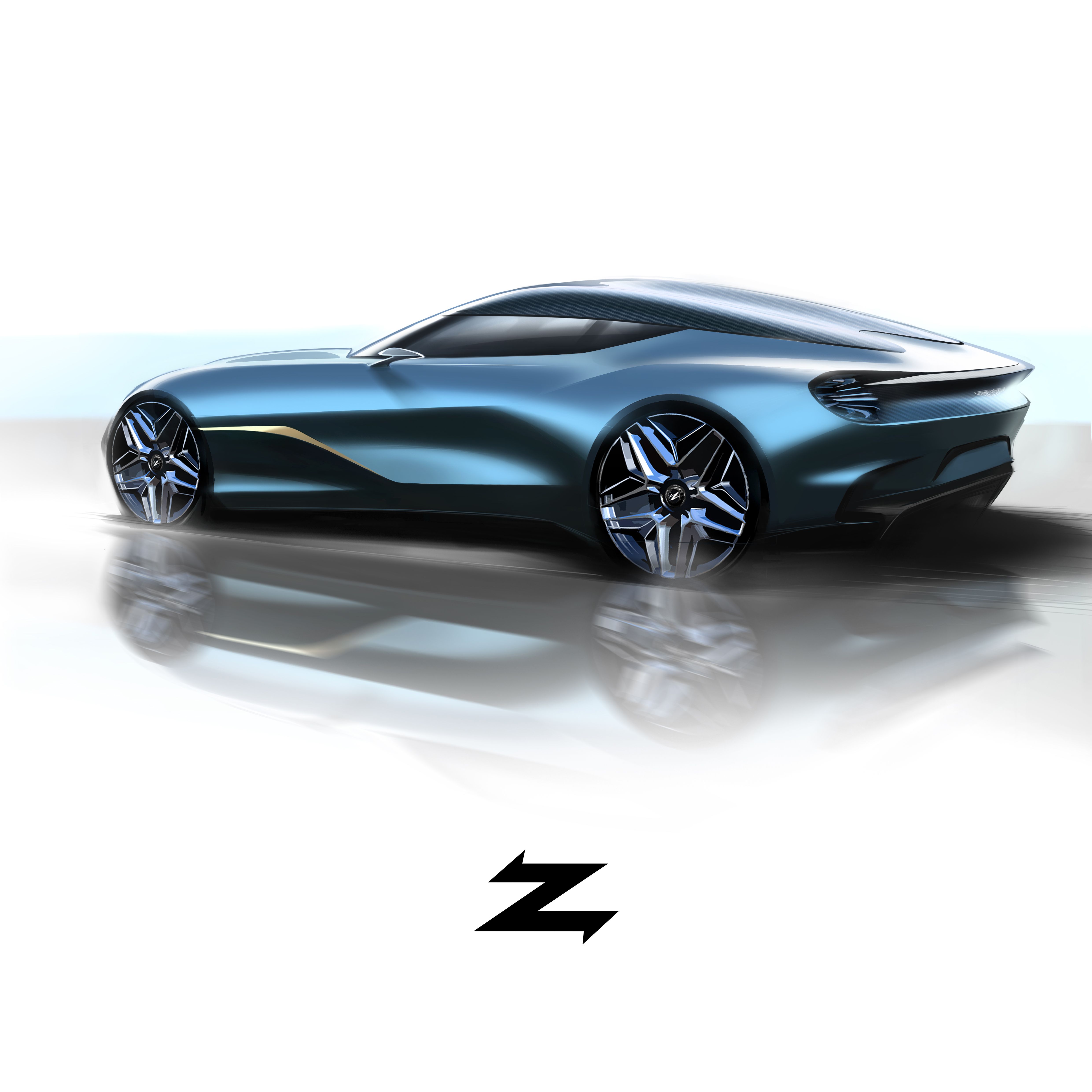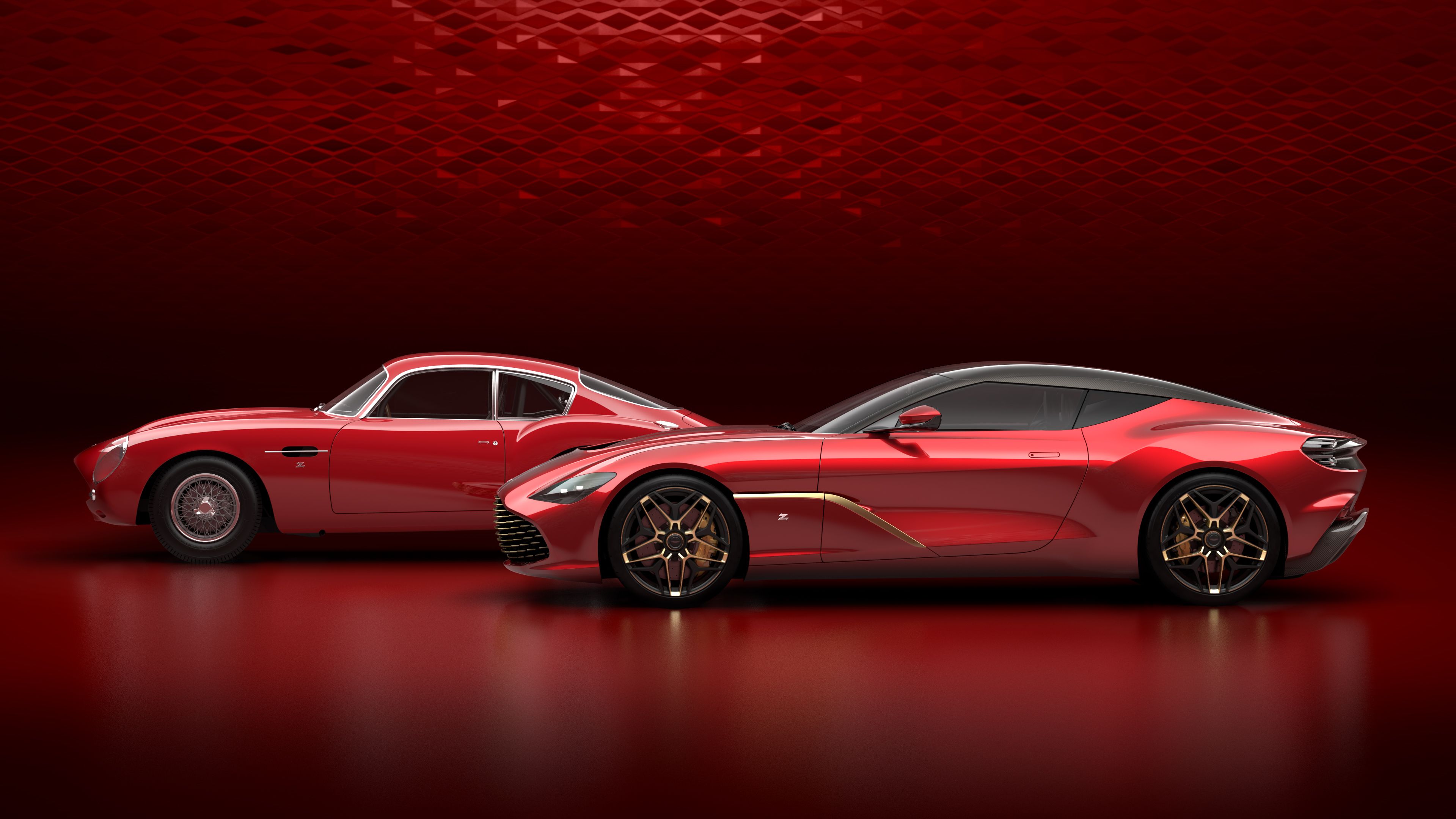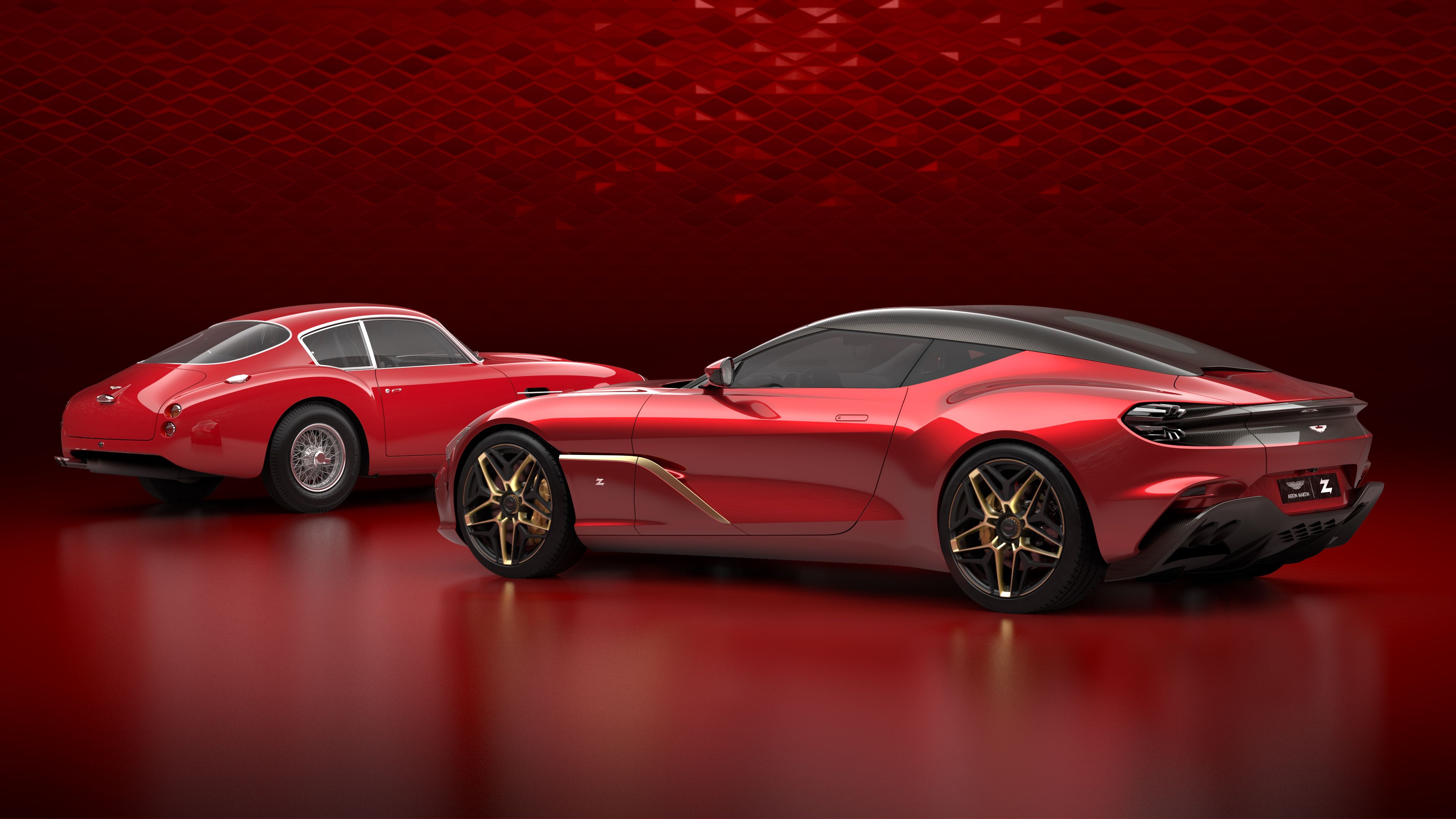Aston Martin unveiled the final exterior design of the upcoming DBS GT Zagato, a limited-edition vehicles based on the DBS Superleggera. Just like the Vanquish-based Zagato models from 2018, the DBS GT Zagato will be built in very limited numbers. However, while the Vanquish Zagato was built in four body styles -- coupe, convertible, shooting brake, and speedster -- the DBS Zagato was unveiled as a coupe only. Another big difference is that the DBS Zagato will be sold in a pair with modern replicas of the iconic DB4 GT Zagato. The latter is basically the spiritual predecessor of the DBS GT Zagato.
The Aston Martin DBS GT Zagato Looks the Part
}0}
Just like the Vanquish-based Zagato before it, the DBS GT Zagato boasts a massive grille up front. Made from 108 diamond-shaped carbon-fiber pieces, the element occupies most of the bumper and the nose, so the DBS GT Zagato looks like it's ready to swallow everything in its path. But this is more than just a huge opening. When the car is stationary, the carbon elements remain flush with the body, but each of the 108 pieces come to life and open up to allow air into the engine when the ignition is on. They also have a gold tint on their edges for a striking contrast with the bright red body.
Zagato also meddled with the DBS headlamps, making them bigger and more angular at the corners. While the standard DBS lights are small and rather dull, Zagato's design enhances the aggressiveness of the front fascia. The new design is rounded off by a revised engine hood with a massive vent in the center. Inspired by race cars from the 1960s, it looks as if the center section was cut off and pushed toward the engine, creating an outlet that opens up as it moves toward the nose.
Zagato made extensive modifications to the DBS' profile as well. The first feature the catches the eye is the rounded side skirts. While modern sports cars have protruding side skirts, Zagato took a vintage approach and streamlined them. The side skirts are pretty much gone, as the DBS is now narrower in the lower area. This is yet another feature borrowed from the old DB4 GT Zagato. The typical Aston Martin strake on the front fender now extends into the door, where it breaks downward at a 45-degree angle and trickles into the side skirts. This inserts is finished in gold, just like the front grille and the five-spoke wheels. A big "Z" on the front fender reminds us that this body was penned by Zagato.
The profile also shows us the redesigned roof, now with a more aggressive slope toward the back. The big news here is that the entire roof is made from carbon-fiber, including the upper C-pillars and the area around the rear window. The window itself was redesigned as well, now sporting an oval shape.
The rear fascia is a complete redesign. Zagato ditched the really slim taillights and crafted an upper fascia from carbon-fiber. It now has a big dent in the center that runs the entire width of the rear end. The spoiler on the deck lid is also gone. Instead of the long and thin lights, Zagato went with a 3D design that combines horizontal poles in a round shape. The "taillight" is divided at the center in some sort of throwback to the DB4 GT Zagato, which features a pair of round lights, disposed vertically, on each side.
The license place recess was moved a tad higher into the fascia, while the diffuser grew bigger and now sits at a 45-degree angle to the ground. The tailpipes were also reshaped to match the new angle of the diffuser and the entire lower bumper now looks like it's been taken off a race car.
Overall, the DBS GT Zagato is a cool and fresh interpretation of Zagato's trademark design. It pays tribute to the old DB4 GT Zagato, but it's also modern thanks to heavy use of angular line, carbon-fiber components, and race-inspired cues.
Aston Martin DBS Superleggera Drivetrain Specifications
| Engine | All-alloy quad overhead cam, 48-valve 5.2-litre bi-turbo, V12 with stop/start cylinder deactivation |
|---|---|
| Cooling | Water-to-air Charge |
| Drive | Front mid-mounted engine, rear-wheel drive |
| Compression ratio | 9.3:1 |
| Maximum power | 715 HP @ 6,500 RPM |
| Maximum torque | 663 LB-FT @ 1,800-5,000 RPM |
| Acceleration 0-62mph (0-100km/h) | 3.4 seconds |
| Maximum speed | 211mph |
| Transmission | Rear mid-mounted ZF eight-speed automatic |
The Aston Martin DBS GT Zagato is part of a two-car deal
Just like previous Zagato-built Aston Martins, the DBS GT Zagato is a limited-edition series. Only 19 will be built and it's safe to assume that they're already sold out. But here's the interesting thing. Unlike other Zagato cars -- or any other vehicle for that matter -- the DBS Zagato GT is part of two-car deal. If you want the DBS GT Zagato, you'll also get a DB4 GT Zagato. The pricing for both? A whopping £6 million.
Now before you get all excited about the classic DB4 GT Zagato, you should know that it's just a continuation model. This means that the 19 cars are not part of the original run from the early 1960s. They're not even part of the second and third runs from the late 1980s and 2000, when Aston Martin decided to use some left-over chassis and bodies. The Brits simply decided to recreate the iconic DB4 GT Zagato in the 21st century.
Mind you, the original DB4 GT Zagato is awfully expensive. Only 19 were built and most of them cost in excess of £5 million at auctions. One specific unit was actually sold for a solid £10 million in 2018.
Continuation cars are definitely more affordable, but they're still expensive for the average Joe, especially since they're sanctioned and built by Aston Martin itself. Zagato-designed Aston Martins are pretty expensive as well, so I guess that the £6 million sticker makes some sense.
Production of both models will commence in 2020, so expect deliveries to start toward the end of the year.
The Aston Martin DBS GT Zagato is based on a rare and iconic car
The DBS GT Zagato is obviously a tribute to the DB4 GT Zagato. Based on the Aston Martin DB4 built from 1958 to 1963, the DB4 GT Zagato is one of the most iconic and recognizable Aston Martins ever designed. Penned by Ercole Spada, who also designed the Alfa Romeo Giulia TZ, Lancia Fulvia Sport, the second-gen BMW 7 Series, third-gen BMW 5 Series, and the Lancia Delta, the DB4 GT Zagato was produced from 1960 to 1963.
Its design was inspired by touring race cars from the late 1960s, so the DB4 GT Zagato turned out as a significantly more aggressive version of the standard DB4. The body was smaller, more aerodynamics, and the car was lighter overall as many steel components were replaced with aluminum ones. Zagato also removed the bumpers in order to save weight. Overall, the DB4 GT Zagato was more than 100 pounds lighter than the original DB4.
The cars were fitted with 3.7-liter inline-six engines rated at 314 horsepower and 278 pound-feet of twist. The Zagatos needed only 6.1 seconds to hit 60 mph, to go with a top speed of 153 mph, impressive figures for the era.
Aston Martin DB4GT By Zagato specifications
| Engine | Aluminum, Twin Spark, Inline-6 |
|---|---|
| Displacement | 3,670 cc |
| Power | 314 HP @ 6,000 RPM |
| Torque | 278 LB-FT @ 5,400 RPM |
| Top speed | 150 MPH |
| 0 - 60 mph | 6 seconds |
Aston Martin sold each car for almost £5,500, enough to buy a sizable house in the early 1960s. For reference, the Rolls-Royce Phantom was priced at almost £7,000 in 1961.
Of the 19 cars built in the 1960s, four chassis were modified and lightened for racing duty. The DB4 GT Zagato was raced at Goodwood and at the 24 Hours of Le Mans in 1961 and 1962. They failed to score notable results, but a DB4 GT Zagato won a British Grand Prix Support race in 1961, ahead of a Jaguar E-Type.
The DB4 GT Zagato made a comeback in 1988 when Aston Martin sent four remaining DB4 chassis to Zagato to have them bodied like the originals. Although they looked like the original cars from the 1960s, they had bigger engines, now at 4.2 liters, and updates that improved their handling. The four cars were completed until 1991 and sold as "Sanction II" DB4 GTs. Each car sold for over $1 million. Two more DB4 GTs were created in 2000 based on two neglected DB4 cars. These were sold as "Sanction III" versions.
Further reading
Read our full review on the 1962 Aston Martin DB4 GTZ
Read our full review on the 2017 Aston Martin Vanquish Zagato
Read our full review on the 2013 Aston Martin DBS Coupe Zagato Centennial
Read our full review on the 2019 Aston Martin DBS Superleggera
Seven Cool Zagato Cars From The Past 20 Years





